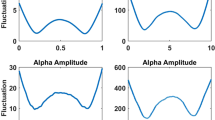Abstract.
This study presents a least mean squares (LMS) algorithm for the ensemble modeling of a multivariate ARMA process. Generally, an LMS algorithm makes possible the tracking of parameters for nonstationary time series. Our estimation incorporates multiple process observations that improve the accuracy of the parameter estimation. As a consequence, the estimation sequences come close to the true model parameters with a fast adaptation speed. This advantage also holds true of spectral quantities (e.g., the momentary coherence), which are derived from the model parameters. Thus the extension of the ARMA fitting from one to multiple trajectories allows the investigation of nonstationary biological signals with an increased time resolution. The applicability of the algorithm is demonstrated for event-related EEG coherence analysis of the Sternberg task. The changing interaction between posterior association cortex and anterior brain area was shown for verbal and nonverbal stimuli by means of the time-variant theta coherence.
Similar content being viewed by others
Acknowledgments.
The authors wish to thank G. Lüer and U. Lass from the Georg Elias Müller Institute of Psychology, Georg August University Göttingen, for their cooperation with the Sternberg task. We also thank Werner Krause from the Institute of Psychology, Friedrich Schiller University of Jena, for the EEG data acquisition and helpful discussions. We are grateful to H. Petsche from the Institute of Brain Research at the University of Vienna who carefully read the manuscript and made useful suggestions for the presentation of our ideas. The study was supported by the Deutsche Forschungsgemeinschaft (project Scha741/1–4).
Author information
Authors and Affiliations
Corresponding author
Rights and permissions
About this article
Cite this article
Möller, E., Schack, B., Vath, N. et al. Fitting of one ARMA model to multiple trials increases the time resolution of instantaneous coherence. Biol. Cybern. 89, 303–312 (2003). https://doi.org/10.1007/s00422-003-0394-x
Received:
Accepted:
Published:
Issue Date:
DOI: https://doi.org/10.1007/s00422-003-0394-x




